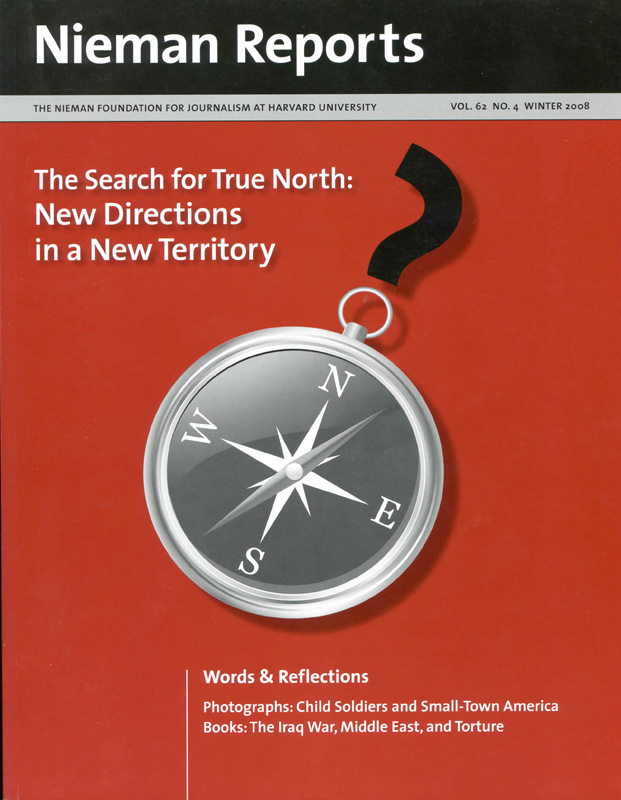In “The Paradox of Choice,” psychologist Barry Schwartz warned of one of the more counterintuitive problems of modern life: the paralysis that can come from too much choice. While “the stress of choice” might pale in comparison to other stresses of modern life, it’s a useful concept in understanding the stresses that newspapers—and their readers—are facing in a digital age. The number of choices an engaged citizen has for reading or watching news has exploded in recent years, and this increase may, paradoxically, mean we encounter less challenging news, and fewer foreign viewpoints, than we used to.
RELATED WEB LINK
“Ethan Zuckerman on how to engineer serendipity online”
– Vijaysree Venkatraman, The Christian Science MonitorAs exciting and challenging as blogging has been as an addition to the media environment, the millions of bloggers writing about current events have probably had less effect on mainstream newspapers than the simple fact that nearly every newspaper is now available online. Alexa, which estimates traffic to Web sites, lists superblog The Huffington Post as the 20th most popular news Web site, the most popular blog in their news rankings. Significantly more popular are the BBC’s site (4th), The New York Times (5th), The Washington Post (13th), The Guardian (17th), Los Angeles Times (18th), The Wall Street Journal (19th), and The Times of India (22nd). The audiences suggested by the Alexa rankings vastly outpace the circulation of these newspapers. The move of newspapers online means that engaged readers can subscribe to a local newspaper and complement local coverage with high-quality national and international news available online.
This could be a golden moment for the fans of high-quality journalism—if only someone can figure out how to continue to pay to produce high-quality journalism at these national and international newspapers.
Discerning readers can triangulate between local newspapers—which have every incentive to focus coverage on local news (sacrificing local perspectives on national and international news)—and world-class newspapers for coverage of the broader world. This is a recent, and important, development. Ten years ago, if you lived in a rural town, as I do, The New York Times was available only at the local library, The Guardian not at all. Broadening your perspective by reading a range of local, national and international newspapers required an investment of time and money that few readers can make. Those investments are now trivial—at least for readers.
Are most readers triangulating in this way, reading broadly and widely, taking advantage of the plethora of choices online? Probably not. Most major newspapers offer information on their Web sites about what stories are most read, most e-mailed, and most blogged. These lists suggest that readers of these papers are obsessed with U.S. presidential politics, stories that involve celebrities, and stories about terrorism.
There’s little to indicate that readers are reading broadly, taking advantage of the comprehensive—and expensive—international coverage these newspapers offer. There’s also little to indicate that readers are paying attention to coverage of national stories not already embedded in news agendas. Instead, these lists suggest that some readers are highly selective in their consumption, seeking and sharing stories as a form of ammunition in ongoing political battles, digging more deeply into issues they already believe to be important.
Making Choices
When newspapers create online editions, they give readers more choices. That’s a subtle but important change. The front page of The New York Times offers “links” to roughly 20 stories. Most of these links include 200-400 words and occasionally a picture or graphic. There’s significant information to draw a reader’s interest in a story. By contrast, the front page of nytimes.com offers more than 300 links, none of which feature more than 30 words of text. By one measure, the online version offers readers far more choice, with roughly 12 times as many stories to select.
The paper edition is a persuasive technology; it is an embodiment of the editor’s argument that certain stories are worth the reader’s attention. The online edition trusts the reader to make up her own mind.
This may not be a wise decision. Homophily—the tendency of “birds of a feather to flock together”—is a basic human trait and not always a desirable one. Sociologists Paul Lazarsfeld and Robert Merton documented the tendency of people living in mixed-race neighborhoods to have more friendships with people of the same race (and with those who have similar educational and financial backgrounds). These relationships affect how humans receive and process information; we are more likely to be receptive to a message delivered by someone who shares our demographic makeup.
In a world of widespread media choice, we rely heavily on cues from peers as to what media are worth paying attention to and what we can safely ignore. We follow links from friends’ blogs to discover stories, read stories e-mailed by friends, or visit sites like reddit or Digg where “communities” vote on which stories should be most popular. In all these cases, we open the possibility that our news will be filtered by people who view the world much as we do, filtering out perspectives that might challenge our assumptions and preconceptions about what’s important and newsworthy.
EDITOR’S NOTE
Sunstein’s article, “Enclave Extremism and Journalism’s Brave New World,” was published in the Summer 2008 issue of Nieman Reports »Harvard law professor Cass Sunstein has studied these issues closely. He warns of the dangers of isolating ourselves in ideological echo chambers. In his research, people who deliberate with like-minded citizens tend to emerge more partisan than before their deliberations. Sunstein worries that we may polarize ourselves simply by reading media that reinforces our existing points of view.
In reaction to Sunstein, there’s a great deal of academic debate about whether political bloggers are more or less likely to read opponents’ views than the average voter. Some studies see clear evidence that bloggers with a strong ideological stance are far more likely to link to bloggers with similar stances. Others see evidence that readers of political blogs are better informed in general than average voters and are informed about arguments across the political spectrum.
If we see evidence that liberals or conservatives choose media that reinforce existing preconceptions and avoid challenging views, it’s likely that we have other biases that govern our consumption of media, including too much of a focus on our nation at the expense of others. If our peers place too much focus on U.S. politics and terrorism at the expense of other important stories, do we end up with less diverse and complex knowledge of the world? Sunstein argues that we tend to surround ourselves with media that reinforce our political prejudices. It should come as no surprise that we also seek out media that focus nearly exclusively on our nation, language and culture at the expense of others around the world. Intensely focusing on our home country and its perspectives might be at least as dangerous as surrounding ourselves with comfortable political opinions.
The Allure of Serendipity
There’s a strong temptation to give readers what they want. The Huffington Post has increased its traffic nearly five-fold in the past year. Some of this traffic growth is surely due to an endless and contentious election. Betsy Morgan, CEO of The Huffington Post and former head of CBSNews.com, suggests another reason for growth—a relentless focus on metrics. On taking the post, she immediately asked staff to provide her with daily traffic statistics, showing which stories generated the most interest. Those stories are heavily promoted on the site’s heavily trafficked front page. It’s a smart business strategy, signaling to the site’s employees and unpaid contributors what stories are most likely to be celebrated and amplified by editors and appreciated by the site’s readers.
This strategy has a downside. Too much reliance on viewer metrics by newspapers could have an important unintended consequence—a decrease in a publication’s ability to provide serendipity. Serendipity is the wonderful experience of stumbling upon something you didn’t know you wanted to know. It’s a surprisingly powerful tool for helping people break out of echo chambers of all sorts. If you stumble upon a story that appeals to your interest in rugby, model railroads or rainbows, even if it’s from a part of the world you have no explicit interest in, it may capture your attention and broaden your worldview.
Serendipity is tricky to engineer. It’s difficult to provide information that’s both surprising and relates to a reader’s unstated interests. Librarians engineer serendipity in open stacks by organizing books by topic, allowing eyes to stray from the requested volume to related ones. Retailers hope to increase purchasing by making it easy to stumble upon items you were surprised to remember you “needed”—the beer display at the end of the diaper aisle is an attempt to create a serendipity for the father sent to the store for baby supplies.
For years, one of the best sources of serendipity has been the front page of daily newspapers. Many front page editors reserve a space, often below the fold, for a story from deep within the paper that isn’t directly related to the day’s headlines. This may be a way of featuring the rich storytelling within a newspaper that a reader might otherwise miss, but it frequently leads readers to make unexpected connections between issues and communities. This ability to guide readers to stories they didn’t know they needed to read is one of the key functions of printed newspapers and one we shouldn’t engineer away as we move to the Web. Instead, we need to take on the challenge of creating serendipity in digital media, recognizing the problems associated with the paradox of choice and building media that help us find the information we need, not just the information we think we need.
Ethan Zuckerman is cofounder of the global citizen media Web site, Global Voices (globalvoicesonline.org) and a research fellow at the Berkman Center for Internet & Society at Harvard University.



